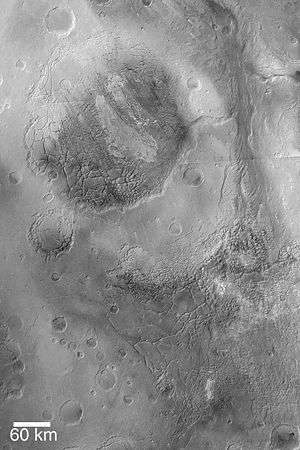Aram Chaos
|
Aram Chaos is the circular depression in the top left. Iani Chaos is in the bottom right. | |
| Planet | Mars |
|---|---|
| Coordinates | 2°36′N 21°30′W / 2.6°N 21.5°WCoordinates: 2°36′N 21°30′W / 2.6°N 21.5°W |
Aram Chaos, centered at 2.6°N, 21.5°W,[1] comprises a heavily eroded impact crater on the planet Mars. It lies at the eastern end of the large canyon Valles Marineris and close to Ares Vallis. Various geological processes have reduced it to a circular area of chaotic terrain. Aram Chaos takes its name from Aram, one of the classical albedo features observed by Giovanni Schiaparelli, who named it after the Biblical land of Aram. Spectroscopic observation from orbit indicates the presence of the mineral hematite, likely a signature of a once aqueous environment.
Aram Chaos measures about 280 kilometers (170 mi) across, and lies in a region called Margaritifer Terra, where many water-carved channels show that floods poured out of the highlands onto the northern lowlands ages ago. The Thermal Emission Imaging System (THEMIS) on the orbiter Mars Odyssey found gray crystalline hematite on the floor of Aram. CRISM, the spectroscope on the MRO, found hyrdrated sulfates, jarosite, and hematite.[2] Hematite is an iron-oxide mineral that can precipitate when ground water circulates through iron-rich rocks, whether at normal temperatures or in hot springs. The floor of Aram contains huge blocks of collapsed, or chaotic, terrain that formed when water or ice was catastrophically removed. Elsewhere on Mars, the release of groundwater produced massive floods that eroded the large channels seen in Ares Vallis and similar outflow valleys. In Aram Chaos, however, the released water stayed mostly within the crater's ramparts, eroding only a small, shallow outlet channel in the eastern wall. Several minerals including hematite sulfate minerals, and water-altered silicates in Aram suggests that a lake probably once existed within the crater. Because forming hematite requires liquid water, which could not long exist without a thick atmosphere, Mars must have had a much thicker atmosphere at some time in the past.[3]
-
Quadrangle map of Oxia Palus labeled with major features. This quadrangle contains many collapsed areas of Chaos and many outflow channels (old river valleys). Aram is near bottom.
-

Tography map of Oxia Palus region of Mars showing the location of a number of chaos regions, including Aram Chaos
-
Erosion in Aram Chaos, as seen by THEMIS.
-
Blocks in Aram showing possible source of water, as seen by THEMIS.
See also
| Wikimedia Commons has media related to Aram Chaos. |
References
- ↑ "Gazetteer of Planetary Nomenclature". Retrieved 2006-11-30.
- ↑ Murchie, S. et al. 2009. A synthesis of Martian aqueous mineralogy after 1 Mars year of observations from the Mars Reconnaissance Orbiter. Journal of Geophysical Research: 114.
- ↑ http://themis.asu.edu/discoveries-aramchaos
